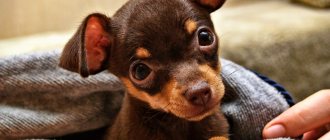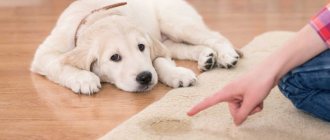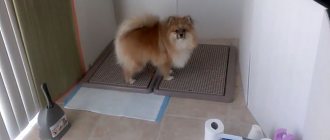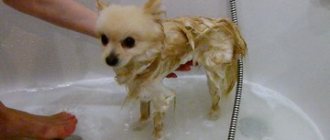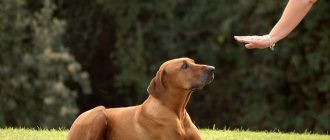Why do you need to walk your puppy outdoors?
For full development, it is important to provide a healthy dog with active movement, and the street is perfect for this. In addition, during a walk, new smells and sounds are learned, which is also an important part of development. On the street, the puppy gets to know other animals, looks attentively, remembers their habits and learns to interact with them.
Dogs need walks in the fresh air
Being in the fresh air, the dog learns the rules of behavior. In this case, all responsibility lies with the owner, because the training of commands and the future behavior of the baby depend on him.
For pets, except decorative breeds, the street is a place where they can relieve their natural needs. To this end, the owner must teach the puppy to go to the toilet outside. If this is not done, then permanent puddles at home are guaranteed.
Having found out how many months you can walk with a puppy, you need to gradually begin to accustom your pet to going outside the apartment.
Important! Frequent walks with puppies and adult dogs are a must.
Huskies, terriers, spaniels, jacks, corgis and labradors especially enjoy long walks. These breeds need space, so it is better to choose parks and forests for walking.
Activities while walking
On the street, everything is interesting for a small pet: different smells, fluttering butterflies, people passing by. If you only watch the pet, allowing her to freely do whatever she wants, there is a risk of losing contact with the pet and getting an uncontrollable animal in the future.
The owner needs to actively participate in learning about the world:
- run with a small pet;
- play with the baby using a ball, rope, stick;
- several times during the walk, voice the basic commands (Come, Fu, Near), training your pet to carry them out at any time.
It is useful to regularly change walking routes with your baby, giving him the opportunity to get to know new places.
A small puppy, like a small child, requires a lot of responsibility and love
How long to wait before your first walk
When can you walk your puppy after the second vaccination?
Of course, any owner who is concerned about the health of their pet is interested in the question of when can they walk their puppy. The first walks should start smoothly. It is important that the dog can get used to the street and not be afraid of the surrounding vegetation and other pets.
The first walk with the puppy should be in warm weather
You also need to know at what age the puppy can be taken for its first walk. So, with strong and healthy pets, you can go for a walk at the age of one and a half months. There are two conditions for such a walk:
- the weather should be warm outside, that is, at least 10 degrees;
- The pet must be held in your arms.
In all other cases, the optimal age is 3 months, when the dog has already received a course of vaccinations. Already at this age, the puppy can walk on its own, and not in the arms of the owner.
The age at which you can walk your puppy also depends on the breed. For example, large guard breeds need to be accustomed to the street from childhood, unlike short-haired representatives. Therefore, it is necessary to organize walks at the age of one month. Decorative breeds do not tolerate bad weather, so the best solution would be to wait until they get stronger and are vaccinated.
Important! The puppy should be taken for a walk in your arms, since its bones are still weak, and it is forbidden for it to move on stairs. This is especially true for the French bulldog breed, which is vulnerable to various types of severity.
Pet owners should find out if their pet's mother is vaccinated. If she has had all her vaccinations, then by the time she gives birth she has strong immunity, which means that the puppy is protected from infection for up to 3 months. In this case, you don’t have to hold him in your arms while walking.
Decorative breeds, Yorkshire terrier, chihuahua, pug, spitz do not need constant walking. Yorkies and other decorative breeds are considered pocket dogs for this reason.
Optimal age for walking
- Many new pet owners try to introduce their pet to the outside world as early as possible. Such a desire deserves praise, but everything has its own subtleties that must be taken into account.
- The most favorable age threshold for a puppy to go outside is considered to be when the puppy reaches 3.5 months. This feature is due to the end of vaccination, which is carried out at an early age, and the end of the quarantine period.
- However, there are some nuances. If you adopted a puppy in warm weather, but some vaccinations have not yet been completed, and you want to take your pet for a walk, this is possible. If the dog is only 2 months old, you can take it out into the fresh air and hold it in your arms.
- Avoid contact with other pets. Also, do not allow people to pet your baby or put him on the ground or grass. After vaccination, the body is not stronger, the puppy may get sick. Even being in your arms, the dog will receive the necessary portion of the sun, feel a light breeze, and feel what it is like to be outside.
- Based on the opinions of some breeders, we can conclude that even a one-month-old puppy is allowed to go for a walk. But this is a dubious theory that is often tried to be refuted. Because this is possible if you know for sure that the puppy’s mother has a strong immune system. Then the baby will be born the same. But again, it's best to stick to your veterinarian's recommendations.
We suggest you read: What can you feed quails besides feed?
Why do puppies need quarantine for the first 2 weeks after vaccination at 3 months?
Is it possible to wash a dog after vaccination: after how long is it allowed?
To protect the life of your pet, after a course of vaccinations, you must comply with quarantine. Animal immunity develops faster against a number of diseases, but protection against leptospirosis and rabies appears only 2 weeks after the course has been completed.
After vaccination, the dog's activity decreases for several days
After vaccination, the dog's behavior must be closely monitored. In the first three days, the dog is characterized by a decrease in activity. Babies may whine in fear. Side effects are also noted:
- refusal to eat;
- itching;
- lethargy;
- intestinal disorders;
- increase in temperature.
A veterinarian's consultation is required if your dog behaves in the following ways:
- The dog itches, chokes, the mucous membrane turns blue. All these are symptoms of anaphylactic shock.
- The temperature reaches 39 degrees, accompanied by weakness, cramps, vomiting and frustration.
Is quarantine mandatory?
Although it seems that vaccination is a fairly simple procedure, after it the dog’s body becomes weakened. During this period, your pet can contract a number of diseases that can be fatal. This is why quarantine is not only possible, but required.
In this case, it means complete isolation from society. If for an adult dog such restriction from the outside world is not necessary, then for a puppy it is vital.
Rules of conduct for 2 weeks after administration of the vaccine:
- Limit the puppy's interaction with other animals.
- Limit contact with objects that may contain viruses (outdoor shoes, etc.).
- Give up the idea of walking your pet.
- Avoid water procedures.
- Do not introduce changes to your usual diet.
- Reduce physical activity.
Important! During immunization, it is worth asking your veterinarian when the puppy can be taken outside. He will be able to determine the time period if the owner is afraid to make a decision himself, and will tell him when walking will be allowed.
How to avoid problems?
In order for you and your pet to have complete mutual understanding, constant training and discipline are required. This is the only way you can achieve the desired result, earn trust and have a good time with your favorite animal.
Show leadership
First, you will definitely need to create a walking strategy. It is quite common for the pet to lead the walk, not the owner. To avoid this, you need to show your dominance.
If the dog tries to chart his path, stop these attempts by calling him to you. In cases where he tries to run away for a long distance, call him back. This way your pet will always remember your presence.
Encourage your pet the moment he runs up. This will help build trusting relationships. The dog will know that you have something tasty for him.
You can practice playing with some kind of toy. Throw it at a distance, the dog must grab the object and return it back. This is a fairly common training tactic.
Rules for walking after vaccination
How long should you really walk your dog?
The first walk with the puppy on the street should leave him with vivid impressions, because it is important that the pet is not afraid to be outside the apartment. For a successful walk, you need to choose the right place. When going out 2 weeks after the vaccine is administered, you should organize a walk in your arms. You cannot let the puppy down to the ground.
A number of rules must also be followed:
- The day should be sunny and calm.
- You should choose a quiet place where there is no waste or other animals.
- The withdrawal time should be no more than 20 minutes.
Before going outside, you need to make sure your pet is feeling well. He should not have lethargy, drowsiness or fever.
Walk in your own area
If the owner has his own plot, fenced from prying eyes, then it will be an ideal option for organizing a walk. The Beagle dog breed will especially like this alternative.
Since puppies are quite curious, before going for a walk you should remove from the area all objects that they can eat. The same should be done with potentially dangerous items. Attention must be paid to the strength of the fence, because while on the site, the baby may want to frolic behind the fence.
Walking outside
Since the street is a public place, a number of rules must be followed:
- Put a collar and leash on the puppy.
- If the weather is cool, then wear warm overalls.
- Watch carefully so that the baby does not pick up any objects from the ground.
Active dogs need to be closely monitored when walking.
Rules for walking an unvaccinated puppy
Next, we will look at the most popular breeds of domestic dogs today and how to walk them correctly, based on the specific nature of the dog in relation to its breed:
- Husky. This breed is very susceptible to diseases of city pets, because its nature was formed and intended for completely different living conditions. Because of their “cleanliness,” huskies are a kind of tasty bait for various parasites - fleas, lice eaters, ticks, etc. Therefore, the owner needs to thoroughly prepare the little pet for the first walk, especially in the city. This breed is more resistant to viral and infectious diseases.
- Chihuahua. The first walk with a puppy of this breed should take place no earlier than the pet is 5-6 months old. Despite their apparent fragility, Chihuahuas have strong immunity and are immune to illness, adapting to any climate. Do not be mistaken when considering a walk with this miniature pet, carrying it in your arms or, especially, in a bag. This is a living and very mobile creature that also needs to warm up. Naturally, it is better for your pet to take its first steps in the fresh air away from roads and strangers, especially dogs. A clearing in a park with short grass is best.
- Dachshunds. They begin to walk pets of this breed only after a full range of necessary vaccinations. In terms of age, this is approximately 3 months. During the first walk, the dachshund will be a little stressed due to fear of the unknown, so it is better to carry out this event without letting him out of your hands for a long time. If the puppy is very active, you can let him out to run, but with a minimum number of strangers. If the dog is frightened of something, do not try to immediately grab it in your arms - pet it, calm it down in an even tone of voice, call it by name. You quickly get used to everything good - and dogs are no exception. If you carry your pet in your arms all the time, he will refuse to run on his own. Under no circumstances should you use the now popular roulette leash when walking your dachshund. Due to the physiology of this breed, this will cause some physical pathologies in the animal.
- Yorkshire Terrier. Many people choose small dogs for themselves, hoping that they don’t necessarily need to be taken out into the fresh air for a walk, and that they can crap at home, once they are trained to use a litter box. But this is absolutely false. The Yorkshire Terrier needs to be walked in the same way as other dogs. Imagine for a second that you are locked in an apartment and are not allowed out. Reclusion will be reflected in depression in the animal; it will simply “fade away”, despite the best conditions and nutrition. Not everyone knows that by its nature this breed is a hunting breed, which was specially bred in old England to catch rodents. Therefore, after the standard first vaccinations, you can safely take your pet out for a walk.
- Jack Russell Terrier. The duration and number of walks with the puppy depend entirely on its age. After quarantine, it is better to take the dog outside for short visits. In wet weather, it is better to reduce the duration of walking as much as possible, since this breed is very susceptible to respiratory diseases. It will not be superfluous to insulate your pet with a blanket. You should not completely cancel walks, this will have a bad effect on your dog’s mood.
- French Bulldog. Quarantine after the first mandatory vaccinations for a French bulldog lasts about a week. Walking is preferable after each meal in order to develop the necessary reflex and routine. Such walks should not be long, but rather become a kind of “potty” trip. It is worth understanding that during the first walks you will have to carry your pet a lot in your arms, since puppies of this breed are contraindicated from walking on steps. If the owner does not know this, over time his dog’s spine will become deformed, the size of its paws will change, and a hernia may appear.
- Puppies approximately 2 months old are allowed to be walked. Particular care should be taken when doing this. Under no circumstances allow your pet to come into contact with other animals or pick up anything from the ground. An excellent option would be the opportunity to let the puppy run around in a private yard, where there are no animals or stray cats.
- If you suddenly decide to release a puppy on your own property, before doing so, the area must be thoroughly inspected and, if necessary, cleaned. Be sure to get rid of various debris and carrion. Make sure your dog doesn't get hurt on anything.
- If you have a large breed puppy, then you need to immediately accustom him to a leash. With such a dog, it is better to immediately start walking long distances. Again, remember to make sure your dog doesn’t pick up anything from the ground.
- When living in the city, it is strongly recommended to walk the puppy in your arms. The dog is allowed to be released only in safe and verified places. Under no circumstances let her off the leash.
- If the weather is warm, walking with your pet is allowed for no more than 1 hour per day. If the weather is rainy or cold outside, wait for the dog to relieve itself and return home immediately.
In order not to encounter certain problems when walking, it is not recommended to change the route in the first days. The puppy should get used to the street without stress and remember the way. You should not feed the animal before going out into the fresh air. Staying outside should not last too long.
how many times a day should you walk the dog
We invite you to read: A puppy appeared in the house on the first day and first night
How to properly walk a puppy without vaccinations
Not all pet owners have had their pet vaccinated. Of course, you can walk an unvaccinated puppy, but you must carefully monitor its behavior on the street and subsequently upon arriving home.
Owners also need to know when they can start walking their puppy outside without vaccination and how to do it correctly. So, you can take him outside for no more than 1 hour. If he feels uncomfortable, then you need to return home as soon as he relieves himself.
Important! In order for the pet to develop correctly, it must be allowed to walk with other dogs.
If you limit your dog's communication, in the future he may display unreasonable aggression towards his own kind or cowardice. The social circle for a puppy without vaccinations should be chosen personally. It is best to let him walk with domestic dogs that are vaccinated. If he is not vaccinated, you can vaccinate yourself with Nobivak.
Walks and practice at home
While it is still not advisable for your puppy to go to public places until he is fully vaccinated, you can start training at home, even if he is only 2 months old. Also, letting your puppy use your backyard as a toilet isn't a good idea either, so it's best to use a leash and take him out somewhere where you can let him do his thing. If you have enough space in your home, you can “walk” him to his bed, to the kitchen for feeding, or even to his pillow in the corner of your office.
When to walk your adult dog after vaccination?
Adult dogs who are already one year old are vaccinated annually, and with a whole complex. A separate injection is often added to the injection, which contributes to the formation of resistance to rabies.
There is no clear schedule for vaccinating male dogs. For females, the vaccination period is selected depending on estrus and mating. In this case, it begins one month before mating begins.
A vaccinated dog, when mated, is subsequently able to give birth to healthy offspring. At birth, puppies receive strong immunity for up to 3 months without vaccinations.
After vaccination, adult dogs should be walked separately from other animals.
It is not prohibited to go for a walk with an adult dog. However, towards the end of the year of life, immunity weakens. Therefore, before and after vaccination, an adult dog should be taken out separately from other dogs for 2 weeks, without allowing heavy loads. To protect your pet, it is better to extend the quarantine period to 3 weeks, as there is a risk of contracting rabies. Plague also poses a threat.
If it’s winter outside, you shouldn’t give your pet a full bath after a walk. It is enough to wash only the paws. If there is a need to clean the fur, it is best to do this with dry shampoo.
At the end of quarantine, the dog is gradually returned to its usual rhythm of life. They remove the ban on swimming in reservoirs, especially if this happens in the summer, and communicating with other dogs. In summer, the dog is shown frequent withdrawal.
Important! The formation of swelling at the injection site is not a pathology and does not require consultation with a veterinarian.
Washing the puppy after a walk
If the puppy gets very dirty during a walk, it is necessary to wash it. For the first time, you should gently walk over the contaminated areas with a slightly dampened rag soaked in warm water, using a high-quality specialized shampoo intended for a puppy. Then wipe with a soft towel and comb the fur.
If you cannot do without thoroughly washing the puppy, then you must follow the following rules. Prepare a basin half filled with warm water (temperature should not exceed 30 degrees). You can measure the temperature of the water with a special thermometer. Be careful not to let water get into your pet's ears.
You should know that experts do not recommend washing your puppy more than once a month. Frequent washing is bad for his coat. Therefore, washing a puppy should only be done in exceptional cases.
The puppy should be fed strictly after a walk. First of all, you should wait until the puppy has rested after a walk (about half an hour or an hour). Then you should put a small amount of food in his bowl. As for water, his bowl should always be filled with it.
A walk brings a lot of positive impressions to the puppy’s daily life. It is important for the formation of his personality and physical activity. Try to set aside enough time for walks with your puppy.



